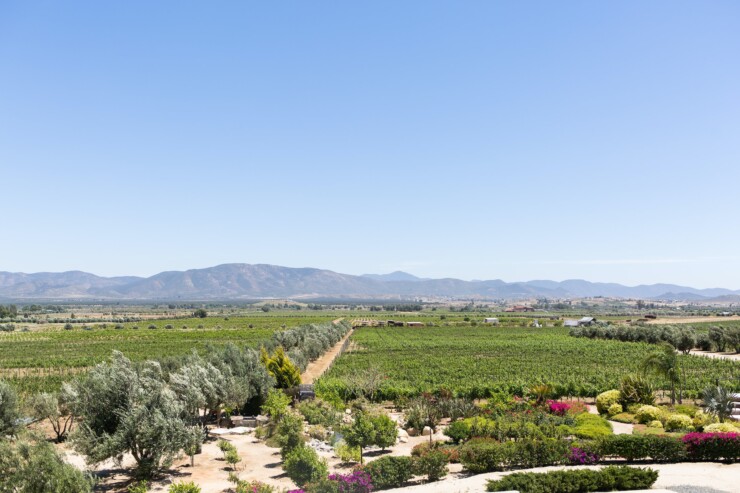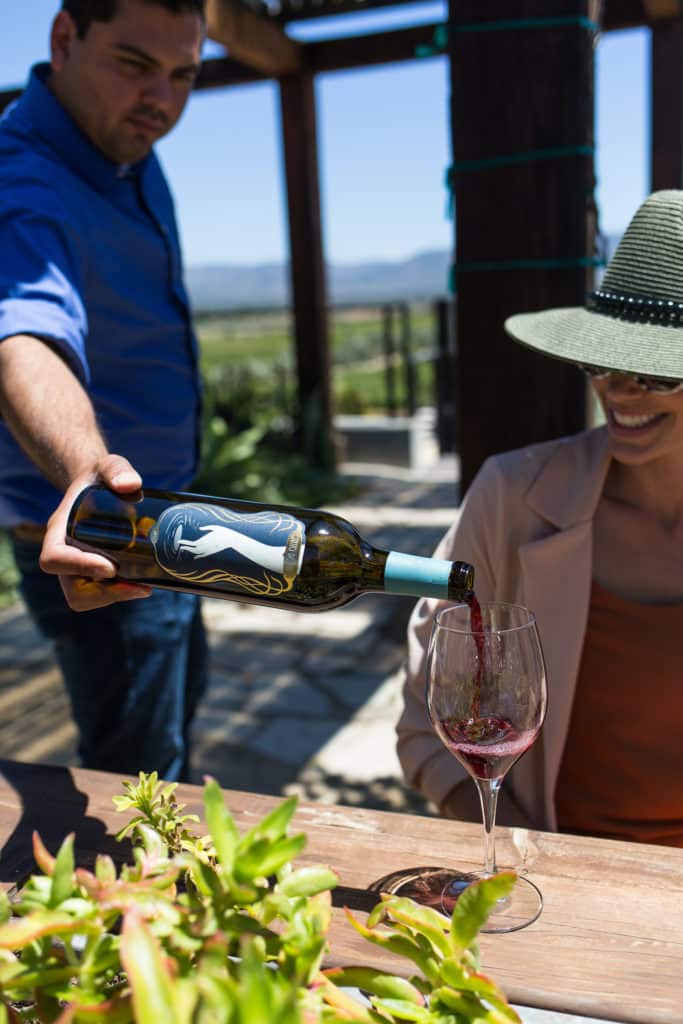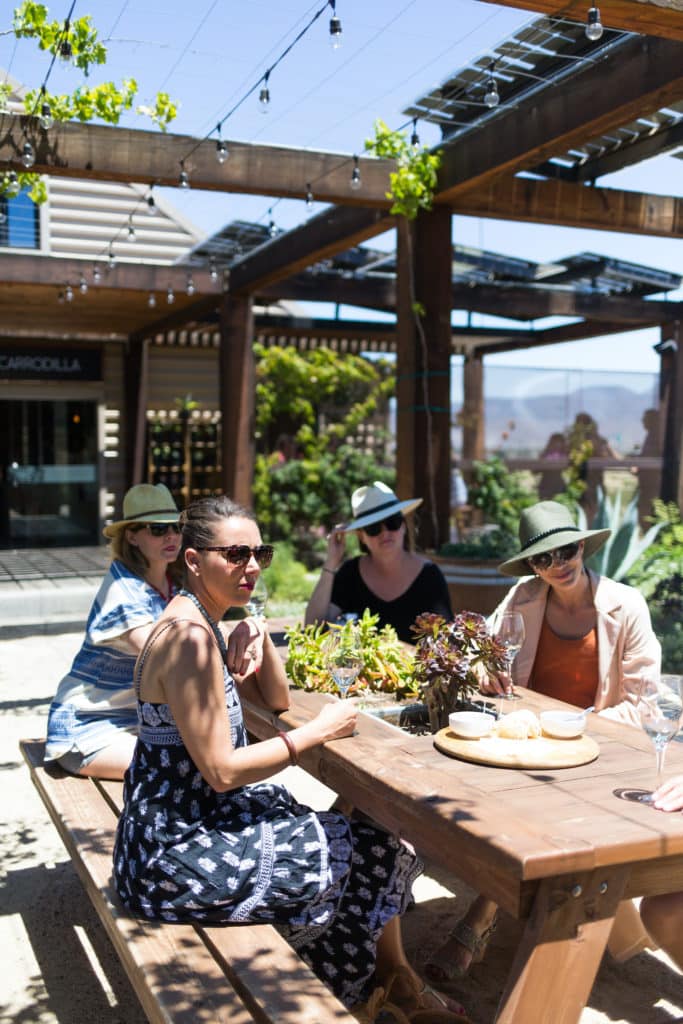Mexico is most definitely the land of beer, tequila, and mezcal. But, in the coastal state of Baja California, it’s all about vino.Considered the heart of Mexican Wine Country, Baja wine country accounts for almost all of Mexico’s wine production and most of the Mexican wine you’ll find in the United States.
Yet Baja California’s reputation as a go-to destination for wine is still a bit off the radar. Maybe it’s because, although wine has been made in Mexico for centuries, its commercial wine industry is comparatively new. Or maybe because California wine country heavyweights like Napa, Sonoma, and the Central Coast are better known. Whatever the reason, we’re excited about wine from Baja California and specifically the area of Valle de Guadalupe.
To introduce you to one of our favorite up-and-coming wine regions, we’re getting into the basics, from its location to what makes the area great for winemaking. We’ll also cover a few Valle de Guadalupe wineries you should know about, from some of the originals to their modern counterparts.

Where is Valle de Guadalupe?
Valle de Guadalupe (aka Guadalupe Valley) is located in the northern Mexican state of Baja California, which also happens to be Mexico’s most western state. If you’re driving across the border, “Valle,” as it’s also called, is less than 100 miles away from the primary San Diego. That means that Mexico’s wine country is less than a two-hour drive from the San Ysidro and Otay Mesa border crossings and Tijuana and just inland from the coastal town of Ensenada.
Most of the region’s wineries, hotels, and excellent restaurants are situated along the main road known as Highway 3—aka a sometimes bumpy, unpaved road known as “La Ruta del Vino.”
However, Valle de Guadalupe is often used as a catch-all term for all wines from Baja California. Other Baja California winemaking areas, like San Antonio de las Minas, Valle de San Vicente, and Valle de Santo Tomas, tend to be lumped into the Valle de Guadalupe umbrella.

Why It’s An Ideal Region For Wine
A hot, dry Mediterranean climate characterizes this wine region and, as a result, it’s often compared to California’s Napa Valley and France’s Southern Rhône region.
Many grape varieties need a balance of warm and cool weather to ripen, and Valle benefits from the nearby Pacific Ocean’s cooling influence. Like California’s Central Coast, the Valle de Guadalupe is oriented more east to west than north to south. The result is there is often a snake of mist and fog in the mornings that winds its way through the valleys and offers a buffer from the blazing sun.
The region’s warm climate means grapes can ripen quickly, so Valle de Guadalupe wines are typically bold and fruit-forward. And, because of the area was once a sea bed, many of hte wines have a salty note or saline quality. Even so, the terroir (or the unique characteristics of the land) changes throughout the region. Grapes grow in sand and a sand-clay mix called loam and granite and clay at Guadalupe Valley’s higher elevations, while in Valle de San Vicente, they grow in red-clay soil and sand. These differences—paired with winemakers’ choices before and after the fruit is picked—influence the styles of wines produced.

History of Wine In Mexico
If you’re still wrapping your head around the idea of (good!) wine in Mexico, know that it is not new. Valle de Guadalupe’s winemaking history dates to the 1500s when Spanish conquistadors planted the Baja California region’s first vines. Back then, wine was produced for religious ceremonies and to ship back to Spain. By the late 1500s, Spain halted wine production in Mexico to protect its domestic production efforts. But missionaries in Baja California continued to make wine on a smaller scale.
In the early 1800s, Dominican priests planted Valle de Guadalupe’s first vines at the Misión de Nuestra Señora de Guadalupe del Norte, or what we know today as Guadalupe Valley.
That continued until the War of Reform during the mid-1800s, when Catholic landholdings were transferred to the state. The state sold these lands to private groups, most notably to a group of peace-seeking Russian emigres. Called Molokans, they fled a potential Czarist draft during the early 1900s and sought refuge in Mexico.
So, while wine was grown in the region, commercial wine production in Valle de Guadalupe didn’t get going until the 1980s when notable European winemakers noticed the region’s winemaking potential. Nowadays, this up-and-coming wine region is home to over 100 wineries of all sizes making wine from all varieties of grapes and styles, from traditional to natural wines.
And, some of the first wineries like Casa Madero—which initially made wine to ship back to Spain—and Bodegas de Santo Tomas (founded in 1888, the region’s first commercial winery) still make wine today.
Grapes Grown In Valle
What makes Baja wine country so interesting is the freedom and creativity winemakers have to experiment. There are no appellation rules in the area, and while some take that to mean there is not enough standardization across the region, we find it allows quality winemakers to experiment.
Currently, winemakers in the area list Malbec, Grenache, Syrah, and Tempranillo as examples of grapes with the most significant potential. And we think Chenin Blanc also makes a strong case for white wine in Baja. But that doesn’t stop winemakers from fermenting and blending other varieties like Nebbiolo and Tempranillo and making wine from some of the first grapes to be introduced to the region, like the historic Misíon grape.

10 Of The Best Wineries Of Valle de Guadalupe
While they don’t have an official organic designation, many Baja region wineries utilize organic farming practices and minimal intervention as part of the winemaking process.
Here are a few top wineries to visit in Valle de Guadalupe:
The Pioneers
L.A. Cetto is a multi-generational winemaking family with Italian roots since 1928 and Mexico’s largest wine producer. They make everything from Cabernet Sauvignon and Nebbiolo to Chenin Blanc and various blends.
Monte Xanic was founded by five friends in 1987. They focus on Bordeaux-style wines and are known for their award-winning Gran Ricardo, but we’re fans of their whites like the Sauvignon Blanc and their Chenin/Colombard blend.
Bodegas de Santo Tomas is Baja California’s oldest winery, having been founded in 1791. Their red blend, for example, features Tempranillo, Carignan, and the local and little-used Misíon grape (brought from Spain in the 16th century).
The Modern Crowd Pleasers
Villa Montefiori was founded in 1997 by the Paoloni family from Italy. Naturally, Villa Montefiori focuses on Italian varieties like Montepulciano and Sangiovese.
Casa de Piedra was also established in the 1990s. Their Vino de Piedra is a Cabernet Sauvignon and Tempranillo blend, but we’re partial to their sparkling wines, which are labor-intensive to produce and thus a rarity in the region. They go exceptionally well with all the local seafood.
Mogor Badan is a small winery making wine from Chasselas, Switzerland’s most famous white grape variety.
The New Generation
Bruma is a small-production winery led by one of the top next-generation Mexican winemakers, Lulu Martinez Ojeda, with ambitions to transition into a solar-powered and biodynamic operation. Wine is made from a combo of estate-grown grapes and fruit from the winemakers’ family.
Lechuza was established in the early 2000s by the Magnussen family from San Diego. Some of the first varieties planted include Nebbiolo and Merlot. Their wines have even made it onto the Michelin-starred French Laundry wine list.
Bodegas Henri Lurton’s family operation blends French winemaking expertise with Baja terroir. They make Chenin Blanc, Sauvignon Blanc, and Nebbiolo.
Finca la Carrodilla is Valle de Guadalupe’s first certified organic vineyard. Their single-varietal wines include Chenin Blanc, Shiraz/Syrah, Cabernet Sauvignon, and Tempranillo. The family-run business also owns La Lomita winery located less than 10 miles away.

Planning A Trip To Mexican Wine Country
If you plan a wine-tasting trip to Valle de Guadalupe, know that most wineries require a reservation. Also, because the area doesn’t have hte best cell service and there are a lot of dirt roads, driving around the area can be challenging. While those with global entry or SENTRI can drive into Mexico in their own car, we can also help you get a professional driver so you can focus on the fun. Also, because it takes a while to get around, we’d advise aiming for at most two tastings in one day.
Regarding when to go, the best time is during the shoulder season (spring or fall) as it can get quite cold at night in the winter and can be seriously hot in summer. While it is a doable (but long) day trip from San Diego, we think the area is best experienced as a two to three-day trip so you can stay at the stunning boutique hotels and enjoy the natural landscape.
Get Ready To Travel To Mexico
Thinking of traveling to Mexico soon? Our travel planning services are here to help you have the ideal vacation. After discussing your preferences during a short consultation, we’ll plan your perfect itinerary. Whether you’re looking for custom travel planning or a small group trip, the Salt & Wind team is here to help. Contact us today to learn more!
More Mexico On Salt & Wind Travel
- The Six Neighborhoods To Visit When You Travel To Mexico City
- From Mexico Con Amor: The Everyday Foods That Originated In Mexico
- From Al Pastor to Carne Asada: A Brief Guide To Classic Mexican Tacos
Have Us Plan Your Mexico Trip
Did you know we’re also a boutique travel agency that specializes in Mexico travel planning? If you’re looking to plan one of the best trips to Mexico, our Mexico trip planner services are here to help you plan your perfect itinerary.
Photo Credit: Photo of a woman looking out on valley by Jackie Bryant; women walking through vineyards by Trevor Gerzen; all other photos by Joanne Pi